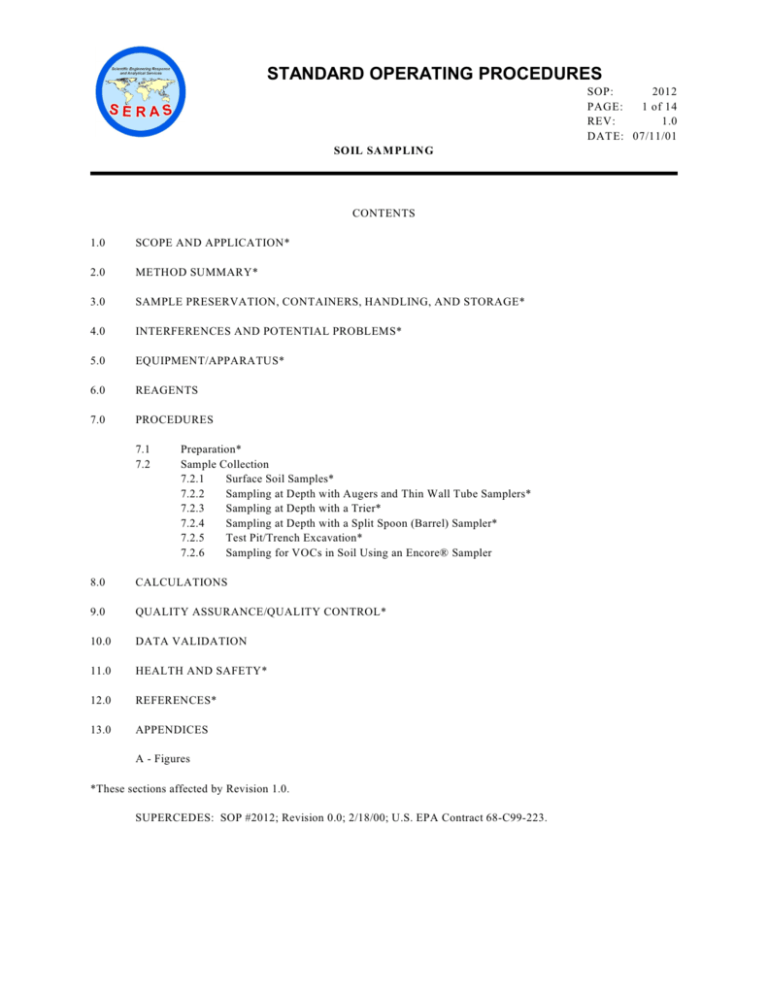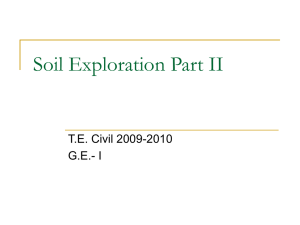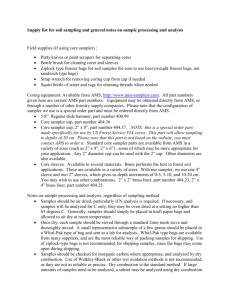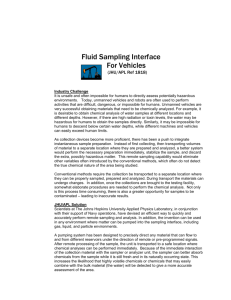Soil Sampling - CLU-IN
advertisement

STANDARD OPERATING PROCEDURES SOP: 2012 PAGE: 1 of 14 REV: 1.0 DATE: 07/11/01 SOIL SAM PLING CONTENTS 1.0 SCOPE AND APPLICATION* 2.0 METHOD SUMMARY* 3.0 SAMPLE PRESERVATION, CONTAINERS, HANDLING, AND STORAGE* 4.0 INTERFERENCES AND POTENTIAL PROBLEMS* 5.0 EQUIPMENT/APPARATUS* 6.0 REAGENTS 7.0 PROCEDURES 7.1 7.2 Preparation* Sample Collection 7.2.1 Surface Soil Samples* 7.2.2 Sampling at Depth with Augers and Thin Wall Tube Samplers* 7.2.3 Sampling at Depth with a Trier* 7.2.4 Sampling at Depth with a Split Spoon (Barrel) Sampler* 7.2.5 Test Pit/Trench Excavation* 7.2.6 Sampling for VOCs in Soil Using an Encore® Sampler 8.0 CALCULATIONS 9.0 QUALITY ASSURANCE/QUALITY CONTROL* 10.0 DATA VALIDATION 11.0 HEALTH AND SAFETY* 12.0 REFERENCES* 13.0 APPENDICES A - Figures *These sections affected by Revision 1.0. SUPERCEDES: SOP #2012; Revision 0.0; 2/18/00; U.S. EPA Contract 68-C99-223. STANDARD OPERATING PROCEDURES SOP: 2012 PAGE: 2 of 14 REV: 1.0 DATE: 07/11/01 SOIL SAM PLING 1.0 SCOPE AND APPLICATION The purpose of this Standard Operating Procedure (SOP) is to describe procedures for the collection of representative surface soil samples. Sampling depths are assumed to be those that can be reached without the use of a drill rig, direct-push technology, or other mechanized equipment (except for a back-hoe). Sample depths typically extend up to 1-foot below ground surface. Analysis of soil samples may define the extent of contamination, determine whether concentrations of specific contaminants exceed established action levels, or if the concentrations of contaminants present a risk to public health, welfare, or the environment. These are standard (i.e., typically applicable) operating procedures which may be varied or changed as required, dependent upon site conditions, equipment limitations, or limitations imposed by the procedure. In all instances, the ultimate procedures employed should be documented and associated with a final report. Mention of trade names or commercial products does not constitute United States Environmental Protection Agency (U.S. EPA) endorsement or recommendation for use. 2.0 METHOD SUMMARY Surface soil samples can be used to investigate contaminants that are persistent in the near surface environment. Contaminants that are detected in the near surface environment may extend to considerable depths, may migrate to the groundwater, surface water, the atmosphere, or may enter biological systems. Soil samples may be collected using a variety of methods and equipment depending on the depth of the desired sample, the type of sample required (discrete or composite), and the soil type. Near-surface soils may be easily sampled using a spade, trowel, and/or scoop. Sampling at greater depths may be performed using a hand auger, continuous-flight auger, trier, split-spoon sampler, or, if required, a backhoe. 3.0 SAMPLE PRESERVATION, CONTAINERS, HANDLING, AND STORAGE Samples must be cooled and maintained at 4oC and protected from sunlight immediately upon collection to minimize any potential reaction. The amount of sample to be collected, proper sample container type and handling requirements are discussed in the Scientific, Engineering, Response Analytical Services (SERAS) SOP #2003, Sample Storage, Preservation and Handling. 4.0 INTERFERENCES AND POTENTIAL PROBLEMS There are two primary problems associated with soil sampling: 1) cross contamination of samples, and 2) improper sample collection. Cross contamination problems can be eliminated or minimized through the use of dedicated sampling equipment. If this is not possible or practical, decontamination of sampling equipment is necessary. The guidelines for preventing, minimizing and limiting cross contamination of samples are discussed in the Environmental Response Team (ERT)/SERAS SOP #2006, Sampling Equipment Decontamination. Improper sample collection procedures can disturb the sample matrix, resulting in volatilization of contaminants, compaction of the sample, or inadequate homogenization of the samples (when required), resulting in variable, non­ representative results. 5.0 EQUIPMENT/APPARATUS STANDARD OPERATING PROCEDURES SOP: 2012 PAGE: 3 of 14 REV: 1.0 DATE: 07/11/01 SOIL SAM PLING Soil sampling equipment includes the following: C C C C C C C C C C C C C C C C C C C C C C C C C C C C C C C C C C C Site maps/plot plan Safety equipment, as specified in the site-specific Health and Safety Plan (HASP) Traditional survey equipment or global positioning system (GPS) Tape measure Survey stakes or flags Camera and image collection media Stainless steel, plastic*, or other appropriate homogenization bucket, bowl or pan Appropriate size sample containers Ziplock plastic bags Site logbook Labels Chain of Custody records and custody seals Field data sheets and sample labels Cooler(s) Ice Vermiculite Decontamination supplies/equipment Plastic sheeting Spade or shovel Spatula(s) Scoop(s) Plastic* or stainless steel spoons Trowel(s) Continuous flight (screw) auger Bucket auger Post hole auger Extension rods T-handle Sampling trier Thin wall tube sampler Split spoon sampler Soil core sampler - Tubes, points, drive head, drop hammer, puller jack and grip Photoionization detector (PID), Flame ionization detector (FID) and/or Respirable Aerosol Monitor (RAM) Backhoe (as required) En Core® samplers * Not used when sampling for semivolatile compounds. 6.0 REAGENTS Decontamination solutions are specified in ERT/SERAS SOP #2006, Sampling Equipment Decontamination, and the site specific work plan. STANDARD OPERATING PROCEDURES SOP: 2012 PAGE: 4 of 14 REV: 1.0 DATE: 07/11/01 SOIL SAM PLING 7.0 PROCEDURES 7.1 Preparation 1. Determine the extent of the sampling effort, the analytes to be determined, the sampling methods to be employed, and the types and amounts of equipment and supplies required to accomplish the assignment. 2. Obtain the necessary sampling and air monitoring equipment. 3. Prepare schedules and coordinate with staff, client, and regulatory agencies, as appropriate. 4. Perform a general site reconnaissance survey prior to site entry in accordance with the site specific HASP. 5. Use stakes or flags to identify and mark all sampling locations. Specific site factors, including extent and nature of contamination, should be considered when selecting sample locations. If required, the proposed locations may be adjusted based on site access, property boundaries, and surface obstructions. All staked locations should be utility-cleared prior to soil sampling; utility clearances must be confirmed before beginning intrusive work. 6. Pre-clean and decontaminate equipment in accordance with the site specific work plan, and ensure that it is in working order. 7.2 Sample Collection 7.2.1 Surface Soil Samples The collection of samples from near-surface soil can be accomplished with tools such as spades, shovels, trowels, and scoops. The over-burden or over-lying surface material is removed to the required depth and a stainless steel or plastic scoop is used to collect the sample. Plastic utensils are not to be used when sampling for semivolatile compounds. This method can be used in most soil types but is limited to sampling at or near the ground surface. Accurate, representative samples can be collected by this procedure depending on the care and precision demonstrated by the sample team member. A flat, pointed mason trowel to cut a block of the desired soil is helpful when undisturbed profiles are required. Tools plated with chrome or other materials must not be used. The following procedure is used to collect surface soil samples: 1. If volatile organic compound (VOC) contamination is suspected, use a PID to monitor the sampler’s breathing zone during soil sampling activities. 2. Using a pre-cleaned, stainless steel scoop, plastic spoon, or trowel, remove and discard sticks, rocks, vegetation and other debris from the sampling area. 3. Accumulate an adequate volume of soil, based on the type(s) of analyses to be performed, in STANDARD OPERATING PROCEDURES SOP: 2012 PAGE: 5 of 14 REV: 1.0 DATE: 07/11/01 SOIL SAM PLING a stainless, plastic or other appropriate container. 4. 7.2.2 If volatile organic analysis is to be performed, immediately transfer the sample directly into an appropriate, labeled sample container with a stainless steel spoon, or equivalent, and secure the cap tightly to ensure that the volatile fraction is not compromised. Thoroughly mix the remainder of the soil to obtain a sample that is representative of the entire sampling interval. Then, either place the sample into appropriate, labeled containers and secure the caps tightly, or, if composite samples are to be collected, place a sample from another sampling interval or location into the homogenization container and mix thoroughly. When compositing is complete, place the sample into appropriate, labeled containers and secure the caps tightly. Sampling at Depth with Augers and Thin Wall Tube Samplers This system consists of an auger, head, a series of extensions, and a "T" handle (Figure 1, Appendix A). The auger is used to bore a hole to a desired sampling depth, and is then withdrawn. The sample may be collected directly from the auger head. If additional sample volume is required, multiple grabs at the same depth are made. If a core sample is to be collected, the auger head is then replaced with a tube auger. The system is then lowered down the borehole, and driven into the soil to the completion depth. The system is withdrawn and the core is collected. Several types of augers are available; these include bucket or tube type, and continuous flight (screw) or post-hole augers. Bucket or tube type augers are better for direct sample recovery because a large volume of sample can be collected from a discrete area in a short period of time. When continuous flight or post-hole augers are used, the sample can be collected directly from the flights or from the borehole cuttings. The continuous flight or post-hole augers are satisfactory when a composite of the complete soil column is desired, but have limited utility for sample collection as they cannot be used to sample a discrete depth. The following procedure is used for collecting soil samples with an auger: 1. Attach the auger head to an extension rod and attach the "T" handle. 2. Clear the area to be sampled of surface debris (e.g., twigs, rocks, litter). It may be advisable to remove a thin layer of surface soil for an area approximately six inches in radius around the sampling location. 3. Begin augering, periodically removing and depositing accumulated soils onto a plastic sheet spread near the hole. This prevents the accidental brushing of loose material back down the borehole when removing the auger or adding extension rods. It also facilitates refilling the hole, and avoids possible contamination of the surrounding area. 4. After reaching the desired depth, slowly and carefully remove the auger from the hole. When sampling directly from the auger head, proceed to Step 10. 5. Remove auger tip from the extension rods and replace with a tube sampler. Install the STANDARD OPERATING PROCEDURES SOP: 2012 PAGE: 6 of 14 REV: 1.0 DATE: 07/11/01 SOIL SAM PLING proper cutting tip. 7.2.3 6. Carefully lower the tube sampler down the borehole. Gradually force the tube sampler into the soil. Do not scrape the borehole sides. Avoid hammering the rods as the vibrations may cause the boring walls to collapse. 7. Remove the tube sampler and unscrew the extension rods. 8. Remove the cutting tip and the core from the device. 9. Discard the top of the core (approximately 1 inch), as this possibly represents material collected before penetration of the layer of concern. Place the core or a discrete portion of the core into the appropriate labeled sample container using a clean, decontaminated stainless steel spoon. If required, homogenize the sample as described in Step 10. 10. If VOC analysis is to be performed, transfer the sample directly from the auger head into an appropriate, labeled sample container with a stainless steel spoon, or equivalent and secure the cap tightly. 11. If another sample is to be collected in the same hole, but at a greater depth, reattach the auger head to the drill assembly, and follow steps 3 through 11, making sure to decontaminate the auger head and tube sampler between samples. 12. Abandon the hole according to applicable state regulations. Sampling at Depth with a Trier The system consists of a trier and a "T" handle. The auger is driven into the soil to be sampled and used to extract a core sample from the appropriate depth. The following procedure is used to collect soil samples with a sampling trier: 1. Insert the trier (Figure 2, Appendix A) into the material to be sampled at a zero degree to forty-five degree (0o to 45 o) angle from the soil surface plane. This orientation minimizes the spillage of sample. 2. Rotate the trier once or twice to cut a core of material. 3. Slowly withdraw the trier, making sure that the slot is facing upward. 4. If VOC analyses are required, transfer the sample directly from the trier into an appropriate, labeled sample container with a stainless steel spoon, or equivalent device and secure the cap tightly. Place the remainder of the sample into a stainless steel, plastic, or other appropriate homogenization container and mix thoroughly to obtain a sample that is representative of the entire sampling interval. Then, either place the sample into appropriate, labeled containers and secure the caps tightly; if composite samples are to be collected, place a sample from another sampling interval into the STANDARD OPERATING PROCEDURES SOP: 2012 PAGE: 7 of 14 REV: 1.0 DATE: 07/11/01 SOIL SAM PLING homogenization container and mix thoroughly. When compositing is complete, place the sample into appropriate, labeled containers and secure the caps tightly. 7.2.4 Sampling at Depth with a Split Spoon (Barrel) Sampler Split spoon sampling is generally used to collect undisturbed soil cores of 18- or 24- inches in length. A series of consecutive cores may be extracted with a split spoon sampler to give a complete soil column profile, or an auger may be used to drill down to the desired depth for sampling. The split spoon is then driven to its sampling depth through the bottom of the augured hole and the core extracted. When split spoon sampling is performed to gain geologic information, all work should be performed in accordance with American Society for Testing and Materials (ASTM) D1586­ 99, “Standard Test Method for Penetration Test and Split-Barrel Sampling of Soils”. The following procedures are used for collecting soil samples with a split spoon: 1. Assemble the sampler by aligning both sides of the barrel and then screwing the drive shoe on the bottom and the head piece on top. 2. Place the sampler at a 90 degree (90 o) angle to the sample material. 3. Using a well ring, drive the sampler. Do not drive past the bottom of the head piece or compression of the sample will result. 4. Record in the site logbook or on field data sheets the length of the tube used to penetrate the material being sampled, and the number of blows required to obtain the sample. 5. Withdraw the sampler, and open it by unscrewing the bit and head, and then splitting the barrel. The amount of recovery and soil type should be recorded on the boring log. If a split sample is desired, a cleaned, stainless steel knife should be used to divide the tube contents in half, longitudinally. This sampler is typically available in 2- and 3.5-inch diameter tubes. A larger barrel (diameter and/or length) may be necessary to obtain the required sample volume. 6. Without disturbing the core, transfer it to the appropriately labeled sample container(s) and seal tightly. Place the remainder of the sample into a stainless steel, plastic, or appropriate homogenization container, and mix thoroughly to obtain a sample that is representative of the entire sampling interval. Then, either place the sample into the appropriate, labeled containers and secure the caps tightly, or if composite samples are to be collected, place a sample from another sampling interval or location into the homogenization container and mix thoroughly. When compositing is complete, place the sample into the appropriate, labeled containers and secure the caps tightly. 7. Abandon the hole according to applicable state regulations. STANDARD OPERATING PROCEDURES SOP: 2012 PAGE: 8 of 14 REV: 1.0 DATE: 07/11/01 SOIL SAM PLING 7.2.5 Test Pit/Trench Excavation A backhoe can be used to remove sections of soil when a detailed examination of stratigraphy and soil characteristics is required. The following procedures are used for collecting soil samples from test pits or trenches: 7.2.6 1. Prior to any excavation with a backhoe, it is imperative to ensure that all sampling locations are clear of overhead and buried utilities. 2. Review the site specific HASP and ensure that all safety precautions including appropriate monitoring equipment are installed as required. 3. Using the backhoe, excavate a trench approximately three feet wide and approximately one foot deep below the cleared sampling location. Place excavated soils on plastic sheets. Trenches greater than five feet deep must be sloped or protected by a shoring system, as required by Occupational Safety and Health Administration (OSHA) regulations. 4. A shovel is used to remove a one to two inch layer of soil from the vertical face of the pit where sampling is to be done. 5. Samples are taken using a trowel, scoop, or coring device at the desired intervals. Be sure to scrape the vertical face at the point of sampling to remove any soil that may have fallen from above, and to expose fresh soil for sampling. In many instances, samples can be collected directly from the backhoe bucket. 6. If VOC analyses are required, transfer the sample into an appropriate, labeled sample container with a stainless steel spoon, or equivalent and secure the cap tightly. Place the remainder of the sample into a stainless steel, plastic, or other appropriate homogenization container, and mix thoroughly to obtain a sample representative of the entire sampling interval. Then, either place the sample into appropriate, labeled containers and secure the caps tightly; or, if composite samples are to be collected, place a sample from another sampling interval into the homogenization container and mix thoroughly. When compositing is complete, place the sample into the appropriate, labeled containers and secure the caps tightly. 7. Abandon the pit or excavation according to applicable state regulations. Sampling for VOCs in Soil Using an En Core® Sampler An En Core® sampler is a single-use device designed to collect and transport samples to the laboratory. The En Core® sampler is made of an inert composite polymer and reduces the open-air handling of soil samples in the field and in the laboratory; thereby, minimizing losses of VOCs. 1. Assemble the coring body, plunger rod and T-handle according to the instructions provided with the En Core® sampler. STANDARD OPERATING PROCEDURES SOP: 2012 PAGE: 9 of 14 REV: 1.0 DATE: 07/11/01 SOIL SAM PLING 2. Turn the T-handle with the T-up and the coring body down and push the sampler into the soil until the coring body is completely full. Remove the sampler from the soil. Wipe excess soil from the coring body exterior. 3. Cap the coring body while it is still on the T-handle. Push the cap over the flat area of the ridge. Be sure that the cap is seated properly to seal the sampler. Push and cap to lock arm in place. 4. Remove the capped sampler by depressing the locking lever on the T-handle while twisting and pulling the sampler from the T-handle. 5. Attach the label to the coring body cap, place in a plastic zippered bag, seal and put on ice. Generally, three En Core® samplers are required for each sample location. These samplers are shipped to the laboratory where the cap is removed and the soil samples are preserved with methanol or sodium bisulfate. 8.0 CALCULATIONS This section is not applicable to this SOP. 9.0 QUALITY ASSURANCE/QUALITY CONTROL There are no specific quality assurance (QA) activities that apply to the implementation of these procedures. However, the following general QA procedures apply: 2. All data must be documented in site logbooks or on field data sheets. At a minimum, the following data is recorded: Sampler’s name and affiliation with project Sample number Sample location Sample depth Approximate volume of sample collected Type of analyses to be performed Sample description Date and time of sample collection Weather conditions at time of sampling Method of sample collection Sketch of sample location 2. All instrumentation must be operated in accordance with applicable SOPs and/or the manufacturer’s operating instructions, unless otherwise specified in the work plan. Equipment checkout and calibration activities must occur prior to sampling/operation, and must be documented. 3. The types of quality control (QC) samples to be collected in the field shall be documented in the site-specific Work Plan. STANDARD OPERATING PROCEDURES SOP: 2012 PAGE: 10 of 14 REV: 1.0 DATE: 07/11/01 SOIL SAM PLING 10.0 DATA VALIDATION This section is not applicable to this SOP. 11.0 HEALTH AND SAFETY When working with potentially hazardous materials, follow U.S. EPA, OSHA and corporate health and safety procedures, in addition to the procedures specified in the site specific HASP. 12.0 REFERENCES Mason, B.J. 1983. Preparation of Soil Sampling Protocol: Technique and Strategies. EPA-600/4-83-020. Barth, D.S. and B.J. Mason. 1989. Soil Sampling Quality Assurance User's Guide. EPA-600/8-89-046. U.S. Environmental Protection Agency. 1984. Characterization of Hazardous Waste Sites - A Methods Manual: Volume II. Available Sampling Methods, Second Edition. EPA-600/4-84-076. de Vera, ER, B.P. Simmons, R.D. Stephen, and D.L. Storm. 1980. Samplers and Sampling Procedures for Hazardous Waste Streams. EPA-600/2-80-018. American Society for Testing and Materials. Standard Test Method for Penetration Test and Split-Barrel Sampling of Soils. Method D 1586-99. En Novative Technologies, Inc. 2001. En Core® Sampler Sampling Procedures. Web site access. March 13, 2001. STANDARD OPERATING PROCEDURES SOP: 2012 PAGE: 11 of 14 REV: 1.0 DATE: 07/11/01 SOIL SAM PLING APPENDIX A Figures SOP #2012 July 2001 STANDARD OPERATING PROCEDURES SOP: 2012 PAGE: 12 of 14 REV: 1.0 DATE: 07/11/01 SOIL SAM PLING FIGURE 1. Sampling Augers FI U 2. Sampling Trier G RE STANDARD OPERATING PROCEDURES SOP: 2012 PAGE: 13 of 14 REV: 1.0 DATE: 07/11/01 SOIL SAM PLING





